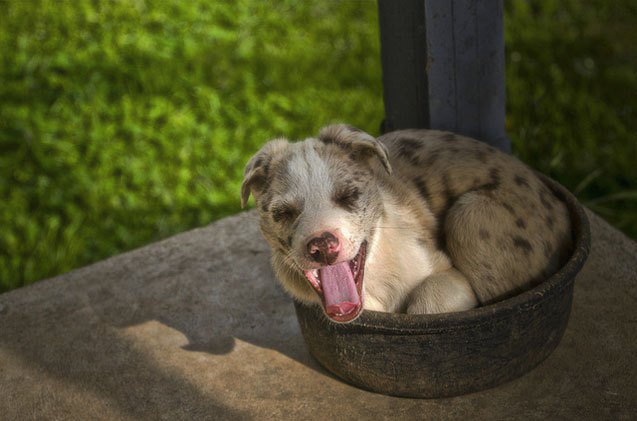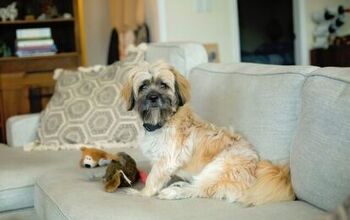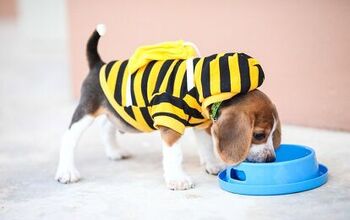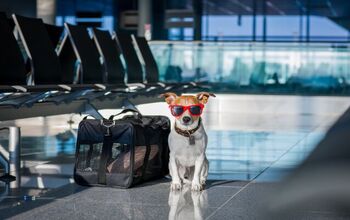What is Resource Guarding in Dogs?

As a dog owner, one of your biggest and most important tasks is to train your dog. For some dogs, this task is easier said than done – especially if your dog has problems like resource guarding. Resource guarding is common, especially in puppies that come from large litters, and it is something you can deal with on your own at home. Here’s what resource guarding in dogs is and how to stop it.
Understanding Resource Guarding in Dogs
Does your dog growl at you if you try to touch him while he is eating? Does he become possessive about his favorite toy or a tasty bone? Does he snap at you or other dogs if someone gets near him when he is enjoying a treat or toy? If you answered “Yes” to any of these questions, your dog may have a problem with resource guarding. Resource guarding is a natural response for dogs because they have an innate need to protect their food and other resources from competitors. This response goes all the way back to wild wolves who would fight each other over food.
Related: What is a Limited Ingredient Diet?
Resource guarding can manifest in a variety of different ways, ranging from seemingly benign behaviors to all-out aggression. On the milder side, many dogs run away with a treat or toy if someone approaches them – they may also growl if someone approaches them while they are enjoying their food or a favorite toy. On the more extreme end of the behavioral scale, some dogs will actually bark or snap at anyone who approaches them. They may even go so far as to bite or chase the offender away.
Tips for Dealing with the Problem
As natural a behavior as resource guarding is, it can also be dangerous – especially if you have young children in the home who do not understand why they can’t approach the dog when he is eating. The last thing you want is for your dog to snap at or even bite your child. Fortunately, there are some simple things you can do to cut back on resource guarding – there are also some steps you can implement early in your puppy’s life to prevent it from becoming a problem. Hand-feeding, for example, is a great way to prevent your puppy from developing resource guarding behavior – you can also speak to the dog while he is eating so he doesn’t feel threatened by your approach.
Related: What Does “Human Grade” Mean When it Comes to Dog Food?
If your puppy already exhibits resource guarding behavior, your approach needs to be a little bit different. The key to dealing with food guarding behavior is to desensitize your dog in a series of stages so he no longer feels threatened. To start, stand a few feet away from your dog as he is eating and periodically speak to him in a non-threatening manner then toss a treat into his bowl. For example, you could say something like “what have you got there,” repeating it every few seconds until he is done eating. When your dog remains calm throughout this process for 10 meals in a row you can move on to the next stage.
In this stage, repeat the process but take a single step toward him as you speak then step back and toss the treat. Each day, step a little closer to your dog until he is relaxed for a full 10 meals with you standing within two feet of his bowl. Next, repeat the process while standing right next to the bowl – right after you drop the treat into it, turn and walk away. When your dog gets use to this, move on to keeping the treat in your hand, bending down to offer it to your dog while he is eating. After he takes the treat, turn and walk away then repeat until he finishes his meal. Next, actually touch your dog’s bowl when you bend down and offer a treat with the other hand at the same time. In the final stage, actually pick up your dog’s bowl to drop the treat in, then put it back.
With these basic tips, you can effectively deal with your dog’s resource guarding behavior. The key is to be patient and do not rush your dog from one stage to the next – make sure he is completely comfortable with one thing before you move on.

Kate Barrington is the loving owner of two cats (Bagel and Munchkin) and a noisy herd of guinea pigs. Having grown up with golden retrievers, Kate has a great deal of experience with dogs but labels herself a lover of all pets. Having received a Bachelor's degree in English, Kate has combined her love for pets and her passion for writing to create her own freelance writing business, specializing in the pet niche.
More by Kate Barrington






















